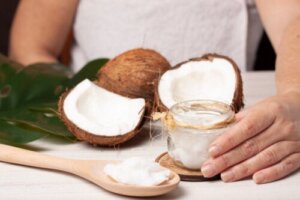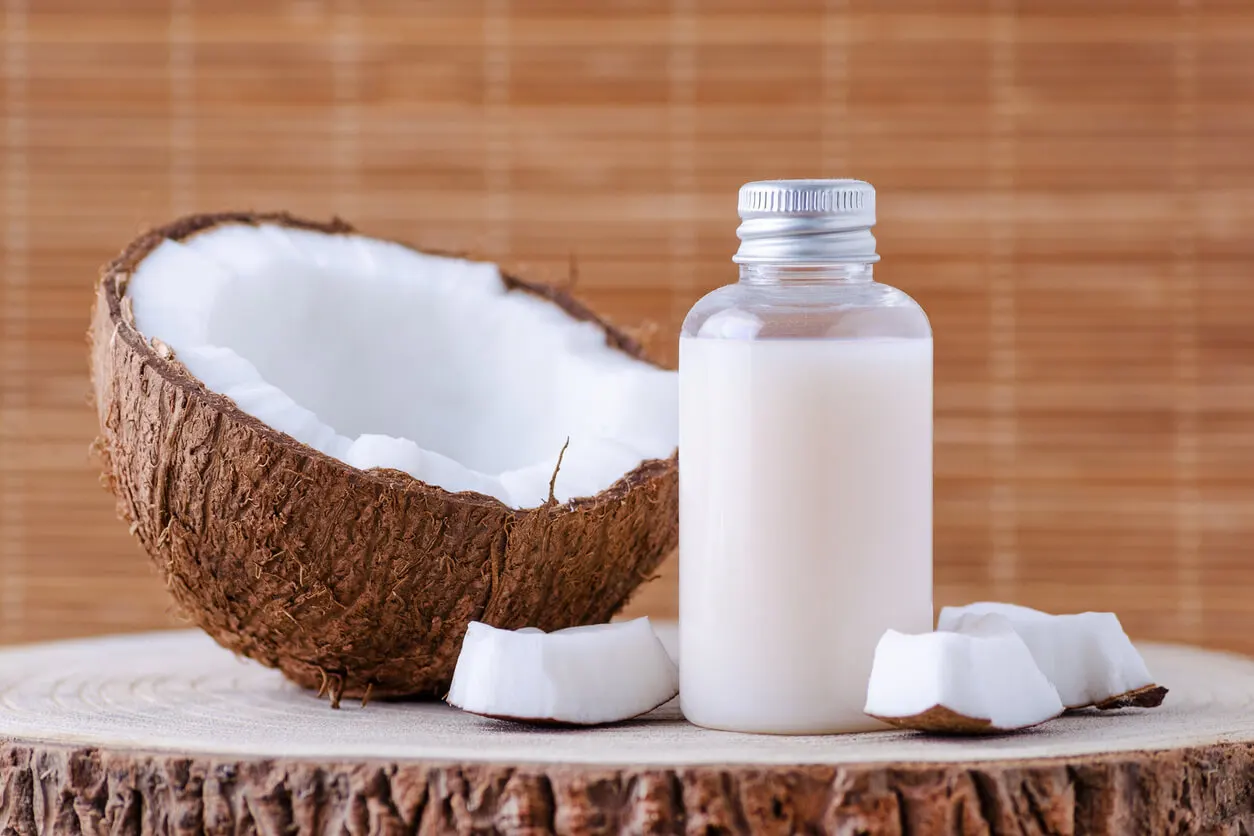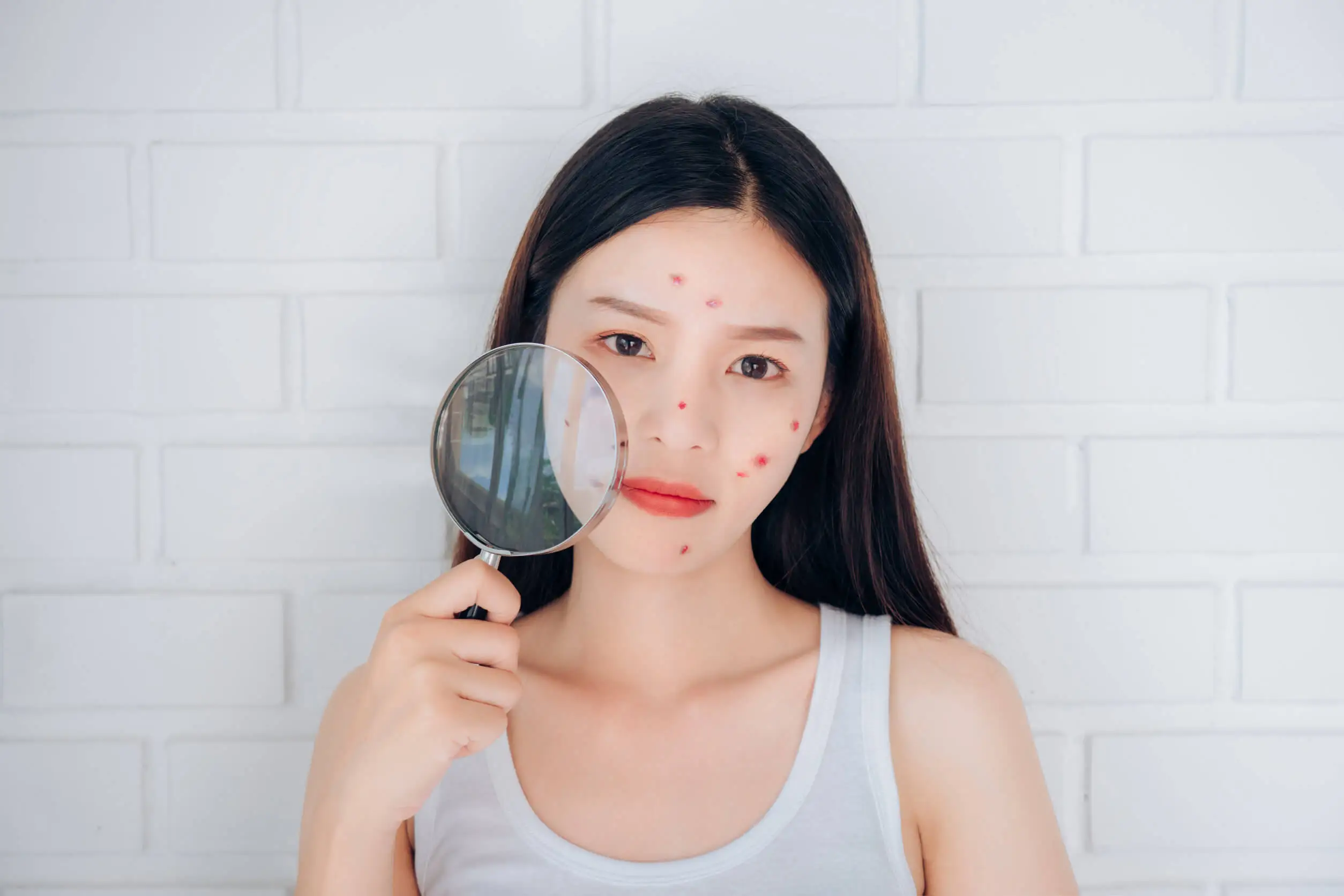Can Lauric Acid Be Used to Treat Acne?

Both in cooking and as a cosmetic, the various uses and applications of coconut oil are well known. But not everyone knows that one of its main active ingredients, lauric acid, is also applied to treat acne.
So, in addition to providing benefits as a skin moisturizer and for hair care, coconut oil can help to treat skin conditions. But this isn’t the only source of this fatty acid, as the ingredient can also be obtained from palm oil and ordinary cow’s milk.
What is lauric acid and where is it obtained from?
Also known as dodecanoic acid (due to the number of carbons in its formula), but more commonly as lauric acid, this is a medium-length saturated fatty acid. It’s of natural origin and is present in the tissues of the human body in solid and insoluble form.
It’s also found in a variety of foods, both animal and vegetable, that contain saturated fats. Among the most common sources are the following:
- Coconut oil: This is one of the richest oils, with an estimated 40% lauric acid content.
- Palm kernel oil: Extracted from the kernel of the Elaeis guineensis palm. Its proportion is much higher, close to 80%.
- Cow’s or goat’s milk: Contains approximately 0.25 grams per cup; 3% of the total milk fat is lauric acid.
Keep reading: Health Benefits of Coconut Oil
Applications and benefits of lauric acid
Coconut oil has a wide variety of uses, ranging from culinary to cosmetic applications. For its part, lauric acid is considered to have several properties that make it effective to treat diseases. Let’s have a look.

Food preservation
Due to its stability and the fact that it’s insoluble in water, this saturated fat is added to food products, helping to preserve them. However, when refined, it loses some of its properties.
Cosmetic uses
This acid is said to have moisturizing properties, so it’s used to combat skin dryness, improving the function of the lipid barrier and helping to combat xerosis.
It’s also a common ingredient in creams and other anti-aging products, to reduce or minimize the marks left by the passage of time. According to a 2013 study, just adding a little virgin coconut oil to skin lotion improves hydration as well as elasticity.
Skin conditions
Coconut oil is also used to treat conditions such as psoriasis, thanks to its moisturizing and anti-inflammatory properties. In this sense, it helps to control the symptoms of this pathology.
Antimicrobial activity
According to the results of various research studies, lauric acid has demonstrated its capacity to inhibit the development of pathogenic organisms. Therefore, it can help in the treatment and prevention of various infections, including colds and flu.
When ingested, it’s converted into monolaurin, a compound with broad-spectrum antimicrobial activity. Other studies have shown that lauric acid has the ability to inhibit the development of pathogenic organisms, such as Staphylococcus aureus under laboratory conditions.
Other benefits
The use of this fatty acid has been associated with other benefits. According to research, Polynesians, whose major source of calories is coconuts, live longer and are healthier, with low rates of obesity and diabetes.
It’s also suggested that it may help us to lose weight more easily and may be a protective factor against Alzheimer’s disease. However, many of its applications are still under study.
Read more here: Improve Your Oral Health with Coconut Oil
Lauric acid for acne: how to use it?
Several factors contribute to the appearance or development of acne. Among these are excessive sebum production, pores clogged by sebum and dead cells, the presence of bacteria (Cutibacterium acnes) and inflammation.
Now, taking into account the antibacterial and anti-inflammatory properties mentioned above, lauric acid could be used to treat acne effectively. This is confirmed by the results of several pieces of research.
For example, in a 2009 study, it was found that this fatty acid reduces both inflammation and the amount of bacteria present on the skin. Likewise, other research conducted in 2016 confirmed these properties.
However, it shouldn’t be applied directly. It’s advisable to purchase and use a product containing the compound, among others. In the case of skin hydration problems or psoriasis, the risks are lower, so it can be used more freely.
For greater safety, a dermatologist should be consulted. This skin health professional can indicate the appropriate dosage for the individual.
There’s no estimate of what the exact amount should be.
Similarly, there’s the option of incorporating ingredients such as coconut oil into the diet. This way you can take advantage of the benefits of lauric acid not only for acne or for the skin. Of course, this also depends on the person’s age and lifestyle.

Possible side effects and contraindications
First of all, it should be noted that lauric acid is a substance that can be irritating, so it shouldn’t be ingested on its own, but in the form of coconut oil or in fresh coconuts.
However, there isn’t much data on the effects it can create. It’s advisable to do a patch test if topical use is to be made. If there are no reactions, then it can be used sparingly.
For its part, the U.S. Food and Drug Administration (FDA) has granted monolaurin the status of a generally safe compound, although without specifying dosage guidelines.
Even so, people with sensitive skin should use it with caution. Likewise, those who are allergic to lauric acid, coconut or palm oil or any of its components shouldn’t use it.
Finally, it’s worth remembering that there are some contraindications to coconut oil. In this regard, its consumption isn’t recommended for people with high cholesterol, hypertension, or those prone to indigestion.
Consult your doctor
Despite all the studies in favor, it hasn’t been found whether lauric acid acts alone or if these benefits are the result of the combined action of all the other components present.
Now, if you consider it a good option to include coconut or palm oil in the diet for acne, remember to take into account the amount of total fat you ingest. And whether for consumption or for topical use, the first thing to do is to consult with your dermatologist.
All cited sources were thoroughly reviewed by our team to ensure their quality, reliability, currency, and validity. The bibliography of this article was considered reliable and of academic or scientific accuracy.
- Dayrit F. The properties of lauric acid and their significance in coconut oil. J Am Oil Chem Soc. 2015; 92: 1–15. https://doi.org/10.1007/s11746-014-2562-7.
- De Roos N, Schouten E, Katan M. Consumption of a solid fat rich in lauric acid results in a more favorable serum lipid profile in healthy men and women than consumption of a solid fat rich in trans-fatty acids. J Nutr. 2001; 131(2): 242-5.
- Kabara J, Swieczkowski D, Conley A, Truant J. Fatty acids and derivatives as antimicrobial agents. Antimicrob Agents Chemother. 1972; 2(1): 23-8.
- Noora N, Aziza A, Sarmidia M, Aziz R. The Effect of Virgin Coconut Oil Loaded Solid Lipid Particles (VCO-SLPs) on Skin Hydration and Skin Elasticity. Jurnal Teknologi. 2013; 62(1): 39-43.
- Office of Food Additive Safety (HFS-CFSAN). Notification for mixture of monoaylglycerides. FDA, 2016. URL: https://www.fda.gov/media/99218/download.
- Prior I, Davidson F, Salmond C, Czochanska. Cholesterol, coconuts, and diet on Polynesian atolls: a natural experiment: the Pukapuka and Tokelau Island studies. The American Journal of Clinical Nutrition. 1981; 34(8): 1552–1561.
- Ruzin A, Novick RP. Equivalence of lauric acid and glycerol monolaurate as inhibitors of signal transduction in Staphylococcus aureus. J Bacteriol. 2000; 182(9): 2668-71.
- Nakatsuji T, Kao M, Fang J, et al. Antimicrobial Property of Lauric Acid Against Propionibacterium Acnes: Its Therapeutic Potential for Inflammatory Acne Vulgaris. JID. 2009; 129(10): 2480-2488.
- Thi-Quynh-Mai T, Hsieh M, Chang K, et al. Bactericidal Effect of Lauric Acid-Loaded PCL-PEG-PCL Nano-Sized Micelles on Skin Commensal Propionibacterium acnes. Polymers. 2016; 8(9). https://doi.org/10.3390/polym8090321.
- Weber TM Kausch M, Rippke F, Schoelermann A, Filbry A. Treatment of xerosis with a topical formulation containing glyceryl glucoside, natural moisturizing factors, and ceramide. J Clin Aesthet Dermatol. 2012; 5(8): 29-39.
This text is provided for informational purposes only and does not replace consultation with a professional. If in doubt, consult your specialist.








